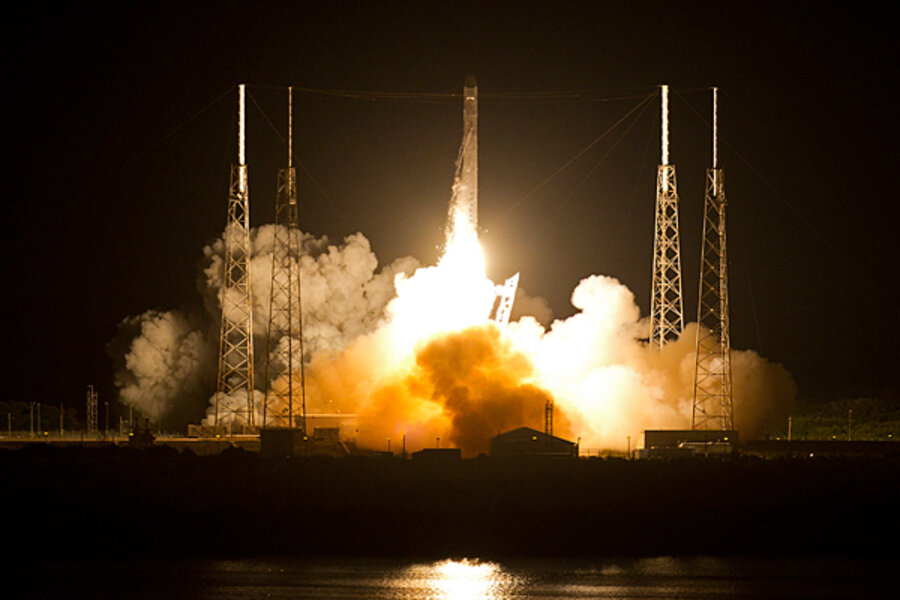With SpaceX launch, more than cargo is riding on space station mission
Loading...
SpaceX's Falcon 9 rocket, topped with the company's Dragon spacecraft, is now three for three after a flawless launch in the predawn hours Tuesday morning.
Coming after two previous successful test launches in 2010, Tuesday's historic mission to the International Space Station marks the first time a commercial company has sent a craft to dock with the orbiting outpost. If all goes well, this mission marks the end of the demonstration phase under a $1.6 billion contract the company has with NASA to resupply the space station.
Tuesday's launch at 3:44 a.m. Eastern Daylight Time from the Cape Canaveral Air Force Station in Florida, was the second try for this mission. The first attempt on May 19 ended a half-second after the engines ignited. A flight-control computer on board the rocket shut off the engines just before lift-off when sensors reported too much pressure in one engine's combustion chamber. Technicians traced the problem to a faulty valve, which they replaced over the weekend.
Once Dragon reached orbit and extended its solar arrays Tuesday morning – a first for the craft – it was cheers, hugs, and high-fives at SpaceX's launch control facility at the Cape as well as at mission control at the company's headquarters in Hawthorne, Calif. Later, sensors crucial to the craft's navigation to and around the space station were exposed to space for the first time and were functioning as designed.
“Anything could have gone wrong, but everything went right,” said Elon Musk, SpaceX's founder and chief designer, referring to the solar-panel deployment during a post-launch press briefing. “There is so much hope riding on that rocket.”
The Falcon 9 is the company's bread and butter. Even before Tuesday's launch, SpaceX had about $4 billion worth of launch contracts in hand through 2017. Sixty percent of the value of those contracts comes from customers other than NASA. The Falcon 9/Dragon package also serves as the foundation for the company's ambitions to contract with NASA to ferry crews to and from the space station.
When the initial stages of the mission came off without a hitch, “people saw their handiwork in space operating as it should,” Mr. Musk said, and the emotions flowed. “For us it's like winning the Super Bowl.”
The experienced hands at NASA were just as impressed with the performance as the young Turks they mentored.
“I've had the pleasure of working down here at the Cape with a lot of fantastic teams that have put together a lot of really quality rockets and launched a lot of amazing things. There is none better than this team,” says William Gerstenmaier, NASA's associate administrator for human exploration and operations, noting the quick recovery from Saturday's launch glitch.
The Dragon spacecraft is carrying just over 1,000 pounds of cargo to the station – items ranging from rations and crew clothing to ice bricks for experiment samples and cargo bags to be used on later missions. And in Dragon's case, what goes up can come down. It's the only resupply craft – current or planned – that can bring cargo back to Earth as well.
The International Space Station's crew watched the launch, which took place as the station passed 249 miles above the North Atlantic east of St. Johns, Newfoundland. With Dragon now safely on orbit, with all systems working as planned, SpaceX is preparing for a series of tests aimed at showing that the autonomous craft can operate safely in the space station's vicinity.
Currently the craft's elliptical orbit brings it to within 37 miles below the station. Throughout the day Tuesday, the craft will conduct rendezvous-abort maneuvers, show it can drift freely with thrusters disabled, and demonstrate its ability to use Global Positioning System satellites for navigation. Meanwhile, controllers will be checking out the craft's navigation sensors, including a radar-like laser system, known as lidar, the craft will use to gauge its distance from the space station.
On Wednesday, the craft is slated to adjust its altitude so that by Thursday it will swing to within 1.5 miles below the station. The craft will undergo additional tests of its GPS navigation system, and the crew aboard the space station will switch on a strobe light on Dragon to confirm the craft is sending and receiving information from a manual control box on the station.
Also on Thursday and into Friday, the craft is slated to fly around the station at a distance of four to six miles, with a carefully choreographed rendezvous and docking slated for Friday.
If all goes well, the station crew will open the craft's hatch on Saturday.
Each of the steps needed to get to that point isn't trivial, Mr. Gerstenmaier suggests.
“Things are moving in the right direction,” he says. But “there are still lots of activities that will occur over the next days that will really stretch the SpaceX team and also stretch the NASA team a little bit as we work together to get to the space station and deliver some demonstration cargo.”
Still, the company's hardware has cleared a critical milestone.
“I would really count today as a success, no matter what happens during the rest of the mission,” Musk says.
To his Twitter followers he added: “Feels like a giant weight just came off my back :)”





